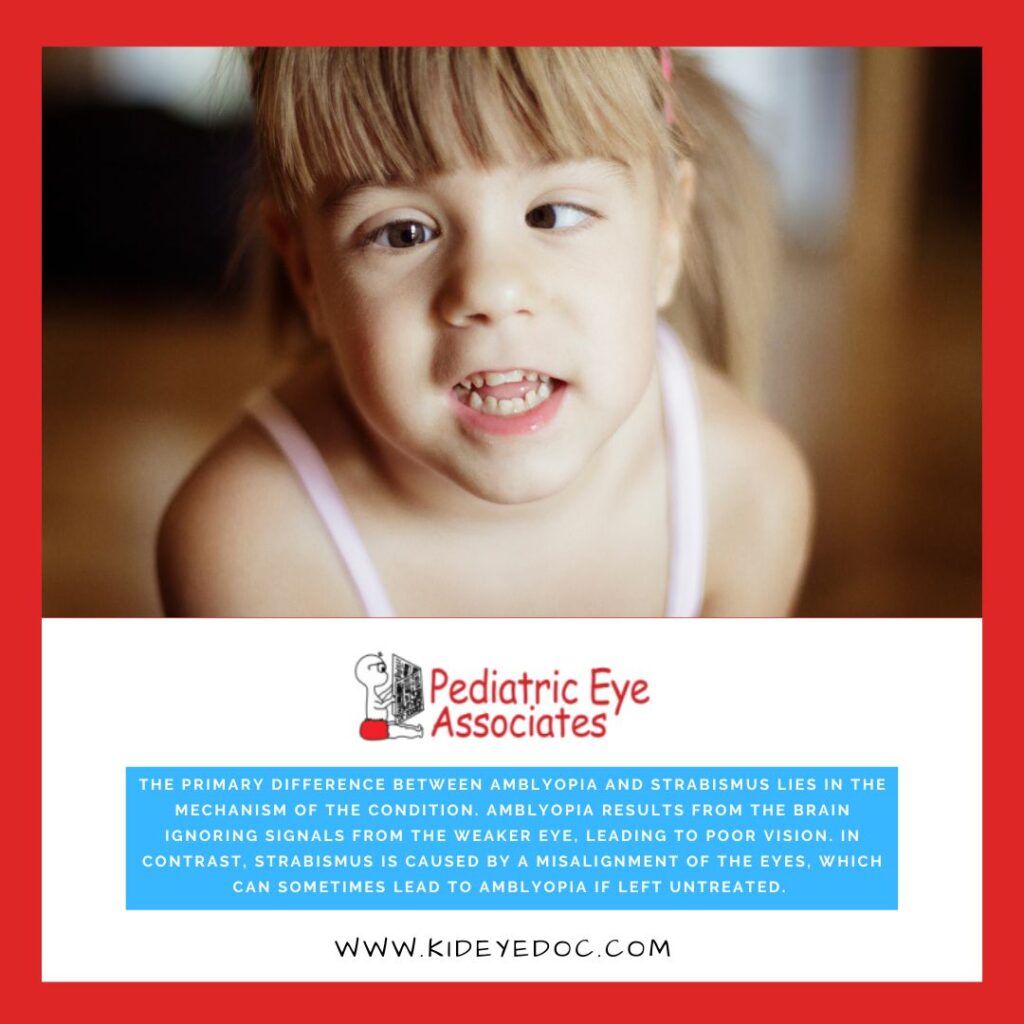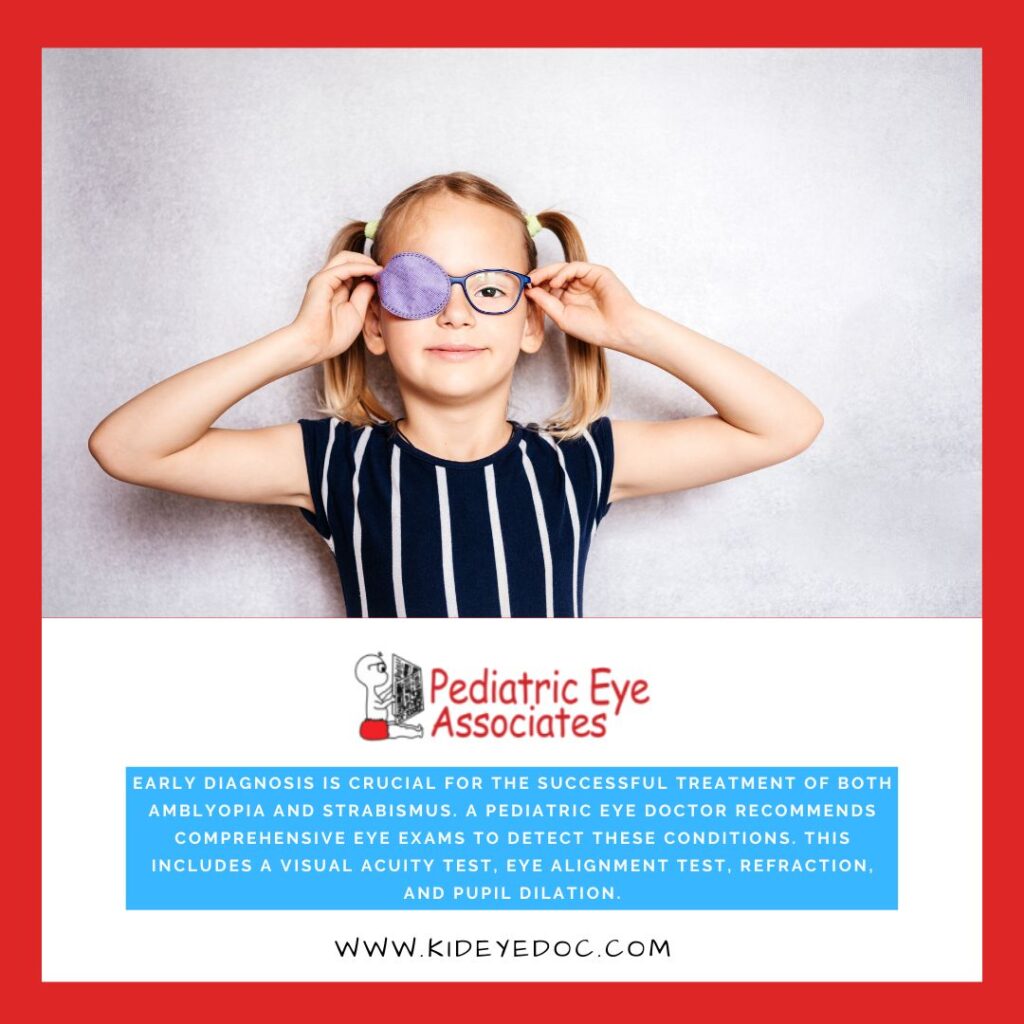Vision problems can significantly impact a child’s development, often going unnoticed until symptoms become more apparent. Two of the most common eye conditions in children are lazy eye (amblyopia) and crossed eyes (strabismus).
While these terms are sometimes used interchangeably, they refer to distinct conditions that require different approaches to diagnosis and treatment. Understanding the differences between these conditions is essential for timely diagnosis and effective treatment.
In this blog post, we will discuss the distinctions between amblyopia and strabismus, their underlying causes, and the available treatment options.
What is lazy eye or amblyopia?
Lazy eye, medically known as amblyopia, is a condition where one eye doesn’t develop normal vision during early childhood. It’s not that the eye itself is “lazy” or structurally damaged in most cases. Instead, the brain favors the stronger eye and starts to ignore the signals coming from the weaker eye. Over time, this can lead to a permanent reduction in vision in the affected eye if left untreated.
Causes of amblyopia
Several factors can contribute to the development of amblyopia, including:
- Strabismic amblyopia: Misalignment of the eyes (strabismus) causes the brain to ignore input from one eye to prevent double vision.
- Refractive amblyopia: A significant difference in refractive error (nearsightedness, farsightedness, or astigmatism) between the two eyes leads to one eye being underused.
- Deprivation amblyopia: Any condition that blocks light from entering the eye, such as cataracts or ptosis (drooping eyelid), can result in amblyopia.
Symptoms of amblyopia
Amblyopia may not be noticeable at first, especially in young children. However, some common signs of this condition include:
- Poor depth perception
- Squinting or closing one eye
- Difficulty with visual tasks requiring accuracy
- Frequent eye rubbing or head tilting
What is crossed eyes or strabismus?
Crossed eyes, or strabismus, on the other hand, refers to a misalignment of the eyes. This means that while one eye might be looking straight ahead, the other eye turns inward (esotropia), outward (exotropia), upward (hypertropia), or downward (hypotropia).
This lack of coordination prevents the eyes from focusing on the same point simultaneously, leading to double vision or the brain suppressing the image from one eye to avoid confusion.
Causes of strabismus
Strabismus can develop due to various factors, including:
- Muscle imbalance: Weakness or imbalance in the eye muscles can prevent the eyes from working together properly.
- Nerve issues: Problems with the nerves controlling eye movement can lead to misalignment.
- Genetic factors: A family history of strabismus increases the likelihood of developing the condition.
- Refractive error: Severe uncorrected farsightedness can cause the eyes to work harder to focus, leading to strabismus.
Symptoms of strabismus
Strabismus is usually noticeable during infancy or early childhood. Common symptoms include:
- Misaligned eyes
- Double vision
- Eye strain or fatigue
- Closing one eye to focus
- Difficulty judging distance
What are the key differences between amblyopia and strabismus?
The primary difference between amblyopia and strabismus lies in the mechanism of the condition. Amblyopia results from the brain ignoring signals from the weaker eye, leading to poor vision. In contrast, strabismus is caused by a misalignment of the eyes, which can sometimes lead to amblyopia if left untreated. Other notable differences are as follows:
- Visual impact: Amblyopia affects visual clarity in one eye due to a lack of use, while strabismus impairs binocular vision and depth perception, which may cause double vision.
- Onset and detection: Amblyopia is often detected during routine eye exams due to reduced vision. On the other hand, strabismus is usually noticed when the eyes appear misaligned or out of sync.
- Risk of co-occurrence: Strabismus can lead to amblyopia when the brain suppresses input from the misaligned eye. However, not all cases of strabismus result in amblyopia.
What are the treatment options for amblyopia and strabismus?
Early diagnosis is crucial for the successful treatment of both amblyopia and strabismus. A pediatric eye doctor recommends comprehensive eye exams to detect these conditions. This includes a visual acuity test, eye alignment test, refraction, and pupil dilation.
Treating lazy eye or amblyopia
Early intervention is key to improving vision in children with amblyopia. Treatment options include:
- Eye patching: Covering the stronger eye encourages the weaker eye to work harder and develop better visual acuity.
- Atropine drops: Applying atropine drops in the stronger eye blurs its vision, forcing the weaker eye to function.
- Corrective lenses: Glasses or contact lenses correct refractive errors and help balance vision between the eyes.
- Vision therapy: Exercises designed to strengthen eye coordination and improve visual processing.
Treating crossed eyes or strabismus
The goals of strabismus treatment are to realign the eyes, restore binocular vision (the ability to use both eyes together), and improve depth perception. Treatment options include:
- Corrective eyewear: Correcting refractive errors can reduce the strain that leads to eye misalignment.
- Prism lenses: Special lenses that help align the eyes and reduce double vision.
- Vision therapy: Exercises and activities can be prescribed to strengthen eye muscles, improve eye coordination, and enhance binocular vision.
- Botox injections: Temporarily weakens overactive eye muscles to improve alignment.
- Eye muscle surgery: This is a common treatment for strabismus. It involves surgically adjusting the muscles attached to the outside of the eye to realign them. The procedure is typically performed on an outpatient basis.
Pediatric Eye Associates: Your Partner in Protecting Your Child’s Vision
When it comes to your child’s vision, early diagnosis and treatment of conditions like lazy eye (amblyopia) and crossed eyes (strabismus) are essential for preventing long-term vision problems.
At Pediatric Eye Associates, we specialize in diagnosing and treating these common childhood eye conditions. Our team uses state-of-the-art diagnostic tools to detect problems early, even before noticeable symptoms appear. We can implement effective treatment plans that restore and preserve your child’s vision by identifying these issues at a young age.
Contact us today to schedule an appointment with the best pediatric optometrist or ophthalmologist.
The material contained on this site is for informational purposes only and DOES NOT CONSTITUTE THE PROVIDING OF MEDICAL ADVICE, and is not intended to be a substitute for independent professional medical judgment, advice, diagnosis, or treatment. Always seek the advice of your physician or other qualified healthcare providers with any questions or concerns you may have regarding your health.



